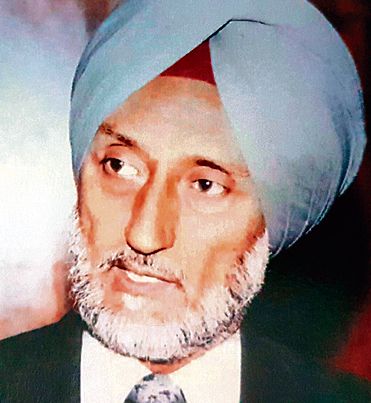Subathu & John Masters
“From the beginning whatever I was supposed to be doing, at least half of me was engaged in watching the slant-eyed men… small and cheerful… had the air of so many gambolling bull-pups, independent, good humoured. I was determined to go to the Gurkhas.” — John Masters
On reading the brief account in The Tribune last month of the regimental reunion at Subathu (Himachal Pradesh) celebrating 127 years’ glorious legacy of service to the nation by 4th Gorkha Rifles, my instant reaction was to WhatsApp a veteran Gorkha, “Gen Sandhu, wasn’t John Masters from 4 GR?” Prompt came the response: “Yes sir, he was from 2/4 GR.”
John Masters was born in Calcutta in 1914 with a century-old indelible genetic imprint to serve in the Gentleman Officers’ brotherhood of the Indian army — in the footsteps of his great grandfather, two uncles and father, that is, 8 King’s Royal Irish Light Dragoons, 34 Sikh Pioneers, 119 Hyderabad Infantry and Commanding Officer of 16 Rajput, respectively! His grandfather had been the Headmaster of La Martiniere School, Calcutta, and his great-uncle had discovered the tea plant growing wild in Assam in 1847!
Leaving nothing to chance, the baby was enrolled for schooling in Wellington from where he entered the Royal Military Academy, Sandhurst; “…being then a few months past my 18th birthday, my suitcases and trunks lay at the wide steps. The Sergeant said, ‘What’s your name, Sir?’ I said, ‘Masters, Sir.’ He said, ‘Don’t call me SIR, Sir. Call me Staff, Sir.’ ‘Mr Lord Greenleaf, you look like a bloody monkey on a stick…!’ We looked at one another out of the corners of our eyes and trembled in our huge hobnailed boots.”
Masters toiled hard, standing first in military history, first in map reading, second in military law and overall topping the merit list of cadets for the Indian army, symbolised by the award of an engraved sword; “…my superiors kept showering congratulation upon me… The General stopped his car, leaped out, and pressed me warmly by the hand… the Adjutant momentarily shifted his gaze and said, ‘Good show, Masters’… Lesser officers wobbled off their bicycles to clap me on the back.”
Yet, the 4th Gorkhas would not accept him without sending for and sizing him up! So the Adjutant had to formally escort him before the Commanding Officer, who said graciously that “...he was pleased I had come to the battalion and hoped I would like it and do well”. However, as Masters stepped out to face his platoon, he “was floundering about like a blind puppy… not at all used to being an officer… could not open my mouth to give an order…”
But all that embarrassment was forgotten when he was “ceremonially dinned-in” in the Regimental Officers’ Mess in the evening. Once every one had assembled and Masters being the ‘guest’ in his soldierly life on this special occasion, the Commanding Officer, Lt Colonel David Murray, DSO, MC, said, “Good evening Masters, what would you have?”
“A gimlet, please, Sir.”
“Orderly, yota gimlet, yota gin-mixie-vermouth-cherry.”
“Hazoor Sahib,” said the Orderly, amiably.
Only after that did the rest of the officers ask for their drink.
Masters had been tutored at Sandhurst about the customs and traditions of the Officers’ Mess and remembered that on the conclusion of the dinner service, the ‘guest’ had to make the first move to leave the Mess. So, he went up to the Commanding Officer and “thanked him for the regiment’s hospitality, stiffened to attention, and said, ‘Good night, Sir’.”
But the ribaldry that followed after the Commanding Officer’s departure was the true measure of the acceptance of Masters into their fold; “...hard fingers were rubbing brandy-butter into my hair and stuffing Christmas pudding into my ears. Oh, ecstasy, I was accepted! Not until that moment did I feel that I had truly joined the regiment.”
Masters, on his part, spared no effort to further the glory of 4 GR as he emerged from WW-II a battle-hardened and proud recipient of the DSO, OBE and three Mentioned-in-Dispatches! And on the flip side, he had also shot a tiger that had strayed into regimental lines at Bakloh, the preserved skin of which is on display in the Garrison Officers’ Mess at Subathu to this day! The attached silver plaque reads: “Shot Bakloh 28th February, 1938. Presented to The Officers Mess, 4th PWO Gurkha Rifles, By Lieutenant J. Masters”.
I had become familiar with John Masters as a historical fiction novelist about a month before I had entered the portals of the Indian Military Academy, Dehradun, when a friend of my father, who was a voracious reader of fiction, loaned me Masters’ first book, ‘Bhowani Junction’, from the 1954 bestsellers’ list. Two years later, on another brief stopover at home, after graduating from the Academy, when I called on the same family friend, he put aside the book he was reading to felicitate me on entering the brotherhood of Gentleman Officers. And pointing at ‘Bugles and a Tiger’, a John Masters’ 1956 release, he said affectionately, “You won’t regret buying this from your first pay cheque!”
Following that affectionate urging from the kindred Sardar Sahib, I had acquired not only John Masters’ latest book (first autobiographical novel), but also one more 1956 publication, the ‘Tree Tops’, being the last of Jim Corbett’s offerings! And both books from the princely Rs 450 monthly salary of an Army subaltern!









